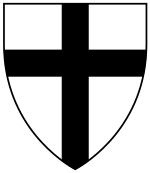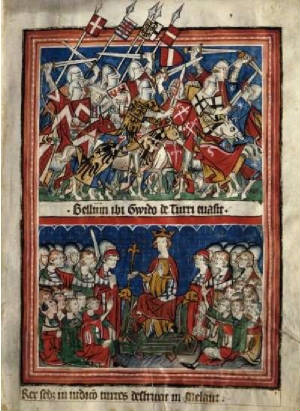


The Milan uprising - 1311
An uprising of the Guelph faction in Milan led
by Guido della Torre (hence also known as the Torriani faction) on 12 February 1311 was crushed by the troops
of king Henry VII still on the same day. Henry had arrived in Milan
some weeks earlier, on 23 December 1310, and had been crowned King of Italy on 6 January 1311. The Tuscan Guelphs refused
to attend the ceremony, and began preparing for resistance. Henry also rehabilitated the Visconti, the ousted former rulers
of Milan, who returned from exile. Guido della Torre, who had thrown the Visconti out of Milan, objected and organised a
revolt against Henry.

Uprising
Around
noon of 12 February, Duke Leopold of Austria, returning from a pleasure ride with few companions, was passing the Torriani
quarter on his way back to his camp outside of Porta Comasina, northwest of the city, when he heard unusual noise of voices,
weapons and horses, and through an open door he could see a congregation of men in full armour. Leopold sent his men back
to his camp with the command to arm his followers, and went to king Henry, who was residing in the city palace, to warn
him of the impending attack. Henry sent his brother Baldwin to fetch the German troops camped outside Porta Romana, southwest
of the city, while a group of knights led by Henry of Flandres and John of Calcea rode to
the Visconti palace and from there to the Torriani quarter, where they were immediately engaged in heavy combat. Henry remained
in the palace, and ordered the palace gates to be barricaded, just in time before the arrival of an armed mob. At the same
time, the contingent of Teutonic Knights arrived, and in a single charge killed or dispersed
most of the rebels. The German chronicles are unanimous in praising the bravery and valour of the knights in this attack,
and especially their leader, the commander of Franconia and later Deutschmeister
Konrad von Gundelfingen. The Austrian reinforcements had been delayed by barricades erected
by the rebels at Porta Comasina. The Visconti reinforcement likewise arrived suspiciously late, in what was afterwards taken
to imply at least passive support of the uprising. When the reinforcements arrived in the Torriani quarter, the fight there
was mostly over. The soldiers now went on to loot the Torriani residences in a massacre that continued until nightfall.
Aftermath
Guido
della Torre escaped, and was condemned to death in absence by Henry. Archbishop Cassone della Torre was exiled. Matteo
I Visconti was also accused of supporting the uprising, mostly by his enemy John of Cermenate. Unlike Guido della Torre
and his sons, who had escaped the city, Matteo Visconti appeared before Henry to receive judgement. The fact that his son
Galeazzo had supported Leopold against the rebels counted in Matteo's favour. Both Matteo and Galeazzo were still briefly
exiled from the city, suggesting that Henry was not fully convinced of their loyalty. The Visconti were soon returned to
power, however, with Henry appointing Matteo I Visconti as the Imperial vicar of Milan. He also imposed his brother-in-law,
Amadeus of Savoy, as the vicar-general in Lombardy. Wernher von Homberg was given the title of lieutenant general of Lombardy,
and was given the right to collect the imperial tax at Flüelen. In the aftermath of the uprising, the Guelph cities of
Northern Italy were turned against Henry, resisting the enforcement of his imperial claims on what had become communal lands
and rights, and attempted to replace communal regulations with imperial laws. Nevertheless, Henry managed to restore some
semblance of imperial power in parts of northern Italy. Cities such as Parma, Lodi, Verona and Padua all accepted his rule.
Historiography
